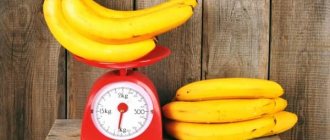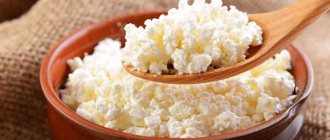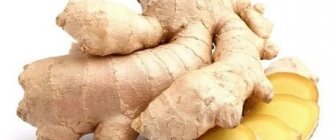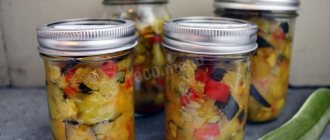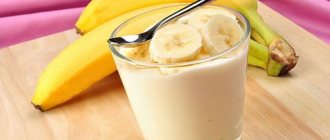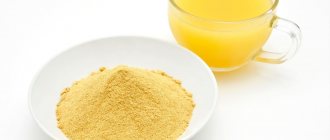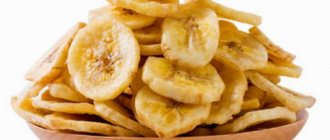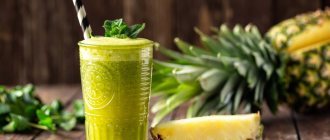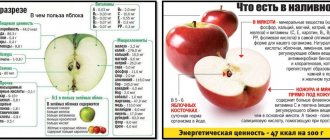How many calories are in 1 banana without peel and 100 grams?
Do bananas contain calories and how many kcal (kilocalories) are in one banana? These questions are asked by those who are planning a diet that necessarily includes various types of vegetables and fruits. Despite the fact that this fruit is considered a healthy delicacy, with a healthy diet it is recommended to carefully consider its caloric content and energy value.
Banana is considered one of the most high-calorie foods
When calculating calories for a day, you need to know: the calorie content (energy value) of one banana without peel (skin) is 120 kcal for an average fruit . The phrase “average fruit” is key here: bananas, like other fruits, differ in varieties and growing conditions, and therefore their energy value can vary significantly. For an overripe fruit (with brown spots and rare dark stripes on the skin) the calorie content will already be 180 kcal - the equivalent of the energy value of 100 g of boiled chicken fillet.
The number of calories in a banana (1 piece) – 110…180 kcal
Baby bananas, sold in attractive bunches in supermarkets, contain 80–90 kcal due to their small size. Slightly sour bananas of the rather rare, “green” variety Platano are distinguished by their low calorie content - about 60 kcal per fruit.
Beneficial properties of banana
Composition and calorie content
Fresh banana contains (per 100g): [7]
Calories 89 Kcal
- Proteins
1.09g - Fat
0.33g - Carbohydrates
22.84g - Water
74.91g - Ash
0.82g
| Vitamins | mg | Minerals | mg |
| Vitamin B4 | 9,8 | Potassium, K | 358 |
| Vitamin C | 8,7 | Magnesium, Mg | 27 |
| Vitamin B3 | 0,665 | Phosphorus, P | 22 |
| Vitamin B5 | 0,334 | Calcium, Ca | 5 |
| Vitamin B6 | 0,367 | Sodium, Na | 1 |
Full composition
So, fresh banana is not very fatty, but very nutritious and energetically valuable product. As for plantains, which require heat treatment before consumption, they are rich in the same minerals and vitamins as dessert bananas. Baking such fruits preserves their beneficial substances, but frying reduces the amount of vitamins and makes them fatter and higher in calories.
Medicinal properties
Despite the fact that a banana consists of 75% water, it contains many useful components. For example, this tropical fruit is very rich in potassium, and thereby helps the body maintain heart and kidney health, and also enhances attention and activates brain function. Scientists claim that a sufficient amount of this mineral in the body prevents the formation of kidney stones, helps normalize blood pressure and reduces the risk of a heart attack by 27%[11]. Magnesium in combination with vitamins C and B6 also has a positive effect on heart function.
In addition, banana is recommended for diarrhea. The fruit itself will not solve the situation, but it will definitely help restore the level of potassium that is washed out of the body during an upset stomach [12]. Bananas also contain dietary fiber, which supports normal bowel function and plays an important role in preventing colorectal cancer. By the way, the antioxidants in bananas can help reduce damage from free radicals, which scientists believe contribute to the development of cancer.
Banana is considered an effective aid in the fight against ulcers because it contains substances that resist the bacteria that cause this disease. It also has an antacid effect (reduces irritation of the mucous membrane, soothes the digestive system) and coats the walls of the stomach.
Bananas are beneficial at any age, but are especially important at the earliest stage of life. So, puree from this tropical fruit usually becomes almost the baby’s first food after mother’s milk. As a rule, bananas do not cause allergies and provide the child’s body with useful substances. Moreover, according to the observations of British scientists, if children eat one banana every day, their risk of developing asthma is reduced by 34%[12].
Eating this tropical fruit also benefits your vision. Despite the fact that carrots are usually associated with a positive effect on the eyes, bananas also contribute to the fight against macular degeneration (damage to the retina and impairment of central vision), thanks to the presence of vitamin A.
Calcium is not found in very large quantities in bananas, but it still helps strengthen bones. In addition, certain indigestible carbohydrates increase the body's ability to absorb calcium from other sources.
Finally, bananas are often, and for good reason, associated with a product for athletes. Minerals and fast carbohydrates saturate the body and charge you with energy and strength for an intense workout. In addition, some scientists believe that bananas help reduce muscle cramps and relieve soreness. However, such an effect has not been scientifically proven.
Likewise, the effect of bananas on a person’s mood has not been proven. The antioxidant dopamine, obtained from bananas, does not affect hormonal levels, so you should not associate its entry into the body with an improvement in mood. And in the case of the amino acid tryptophan, which in the body is transformed into the neurotransmitter serotonin (“the good mood hormone”), its amount in a banana is so small that it can hardly affect the mood.
In medicine
Although bananas are not used in the pharmaceutical industry, they undoubtedly have medicinal properties that are actively used in folk medicine. In tropical countries, where the banana is considered one of the main components of the daily diet, not only the fruit pulp, but also the rest of the plant (roots, leaves, flowers, fruit peel) are used to treat various diseases. For example, it is believed that an infusion of flowers helps with diabetes, ulcers and bronchitis, the roots help with stomach disorders and dysentery, and the leaves help with skin wounds and burns[13]. In our area, the use of banana for medicinal purposes is mainly limited to the use of the fruit and its peel.
Drinks and infusions
For bronchitis, in combination with drug treatment, it is recommended to drink a honey-banana drink. To prepare it, peel and mash 3 ripe bananas, pour 400 ml of boiling water over them, and let the mixture brew for about 30 minutes. Add 2 tablespoons of honey to the cooled mixture and drink half a glass 4 times a day for 5 days.
A chocolate banana drink can help relieve a sore throat. You need to mash 1 ripe banana and add 1 tablespoon of cocoa powder to it. Then dissolve the resulting mixture in 1 glass of boiled milk. Take the product before bed for 5 days.
To combat a dry cough, it is recommended to mash one ripe banana, add 100 ml of orange juice, 200 ml of boiling water, 1 tablespoon of honey and cinnamon to taste. Use the product for 5-7 days. And if you brew a whole banana with the peel as tea, adding a little cinnamon, you will get a cure for insomnia.
Traditional healers claim that 1 mashed banana, poured into a glass of milk, can help the body cope with mild allergic reactions. The drink should be consumed 2-3 times a day. And if you add a little honey to this mixture, you will get a good hangover cure.
Finally, banana kvass is considered to help the body with arrhythmia. To prepare it, place 2 cups of chopped banana peels in cheesecloth and pour in 3 liters of boiled water. Then add 1 tablespoon of sour cream, a glass of sugar and leave for 12 days. A thin layer of mold may form on the surface of the liquid, which must be removed immediately. After 12 days, 1 liter of kvass can be poured and strained through cheesecloth, and to the remaining one add 1 liter of water and a third of a glass of sugar, leaving to steep for a few more days. You should drink half a glass of kvass 2 times a day before meals.
Applications
Banana peel, or less often banana pulp, is used as applications. The inside of the skin acts as a natural antiseptic, and thanks to tannins and wax, it can help stop bleeding. In addition, the oils in its composition help relieve pain and itching. Thus, you can apply the peel or pulp, carefully scraped from it with a knife, to scratches, abrasions, calluses, bruises, burns, and insect bites. Folk recipes also suggest regularly applying banana peels to warts. The result should be noticeable within 3-4 weeks.
In oriental medicine
In Eastern practice, banana is considered a healthy product and is used for various purposes. Particular attention is paid to the ripeness of the fruit, because this greatly affects its medicinal properties. For example, with ripening, a protein appears in a banana, which takes part in preventing the development of cancerous tumors. Conversely, an unripe banana contains resistant starch (dietary fiber), which, according to Indian doctors, improves diabetes.
Eastern medicine also considers banana an effective means of clearing blood vessels. This fruit contains phytosterols that help lower cholesterol levels. According to one recipe, you should pour 50 g of mashed banana into a cup of tea and add 2 teaspoons of honey. This remedy should be drunk morning and evening.
In addition, in Eastern practice it is not customary to combine banana with milk, as is often done in the West. It is believed that such a compound negatively affects the digestion process, can provoke allergies, and can also cause, seemingly completely unrelated, cough and runny nose[14].
In scientific research
Since the banana has many beneficial properties and forms a major part of the diet in many tropical countries, it has long been the subject of scientific research. Scientists are looking for ways to make this fruit more resistant to various diseases, and are also studying its potential as a medicinal product.
For example, a 10-year humanitarian project of a group of Australian researchers was recently successfully completed, the goal of which was to develop bananas rich in provitamin A. This task was set for scientists due to the fact that in Uganda and a number of other African countries hundreds of thousands of children die or become blind due to a lack of this vitamin in the body. Now the problem can be partly solved, thanks to future harvests of “golden” bananas[15]. In parallel, the mechanisms of carotenoid production in bananas are being studied in the USA[16].
Also in the United States, there is a group of scientists from different countries who are studying a compound found in bananas - the protein lectin (BanLec). It was discovered that this protein can become the basis for drugs against viral diseases (influenza, hepatitis C, HIV, etc.). The first experiments showed that it does not allow viruses to penetrate the body's cells, but at the same time causes side effects in the form of irritation and inflammation. Slightly “improved” by scientists, BanLec will gradually be tested on animals, and then on humans[17].
In addition, British scientists are working on creating medicines that will use fiber from bananas and broccoli. This drug is aimed at treating patients with Crohn's disease (an inflammatory disease of the gastrointestinal tract)[18].
In dietetics
Nutritionists recommend banana for inflammatory diseases of the mucous membranes of the duodenum, stomach and oral cavity. It is included in the diet for diseases of the pancreas, as well as some diseases of the liver and kidneys.
As for diets aimed at weight loss, the attitude towards bananas in this area is ambiguous. Some believe that this fruit is too high in calories and should under no circumstances be included in the diet of a person losing weight. Others, on the contrary, argue that bananas, although high in calories, do not contain fat, so they can and should be consumed, but in moderation.
In any case, during a diet it is preferable to eat unripe bananas, which contain starch that has not yet had time to turn into sugar. The glycemic index of such a fruit is only 30 units, while that of a ripe banana is about 50. Thus, the unripe fruit will take longer to digest, will avoid a sharp jump in sugar and will bring longer-lasting saturation.
In cooking
In some tropical countries, where banana is the basis of the diet, it is consumed not only raw or in desserts, but also boiled, deep-fried, and baked over coals. Plantains are usually used to make side dishes. Africans add them to porridges, omelettes, and even soups, and in China bananas can be found in vegetable salads. Sauces, casseroles, chips are made from bananas, flour and ketchup are made from them.
By the way, banana can also come in handy when cooking meat. In order to make it softer and more tender, experienced housewives add banana skins to the pan.
As for the compatibility of banana with other products, it goes well with sweet fruits and nuts. Some nutritionists do not see anything seditious in mixing bananas with dairy products, while others consider such a tandem unacceptable. It is best to eat a banana between meals, separately from other foods.
Beverages
Bananas are used to make a wide variety of drinks, from fresh juices, smoothies and cocktails to tea, coffee, beer and gin. More traditional for us, juices and smoothies, are recommended to be drunk every day between meals or after physical activity. Victoria's Secret nutritionists and trainers advise preparing green juice from a banana, two pears, a stalk of celery, a handful of spinach, lemon and honey.
Coffee lovers can not limit themselves to adding banana syrup to their drink, but also experiment with fresh fruit. So, you need to cool 350 ml of strong coffee, add 100 g of ice cream, 1 banana, a pinch of cinnamon, a little grated chocolate and beat everything in a blender. Then put crushed ice in a glass and pour the drink.
Bananas are also used in alcoholic drinks. For example, in Uganda it is used to make the national drink waragi (homemade gin). Waragi is usually drunk from barrels through special long straws.
Bananas can also be used to make a sweet wine-based cocktail. To do this, take 1 banana, 2 limes, 100 g of chocolate ice cream, 1 tablespoon of powdered sugar for a glass of white Muscat wine and add ice after mixing.
In cosmetology
Numerous studies show that banana is beneficial not only for the health of internal organs and systems, but is also effective when used externally. This fruit is actively used in the development of cosmetics for facial skin and hair care. Global cosmetic giants annually purchase tons of bananas to make various creams, masks, lotions, etc.
Banana is believed to help moisturize the skin, help eliminate wrinkles and contribute to the fight against acne. The recipe for a moisturizing mask is simple: mix half a ripe mashed banana with 1 tablespoon of yogurt and 1 tablespoon of vitamin E oil. Apply to a clean face and rinse off after 30 minutes. In order to make the skin more elastic and elastic, you should mix the pulp cut from a banana skin and one yolk. Keep this mask for 5 minutes and then wash off. To treat acne, simply rub the affected area with the inside of the peel and rinse with water after a few minutes.
In hair care, banana has a nourishing, moisturizing and strengthening effect. To achieve the effect and to avoid difficulties, you must adhere to the following recommendations:
- do not mash the banana with a fork, but beat with a blender until smooth, otherwise the lumps will not be washed out well;
- Before washing off the mask with water, you should apply shampoo to your hair and lather it, otherwise your hair may remain sticky;
- Do not keep the mask on your hair for longer than 20-30 minutes (do not let it dry).
As for recipes, to prepare a nutritious mixture you just need to beat a raw egg with 4 tablespoons of mashed banana. To achieve a moisturizing effect, you need to mix 3 tablespoons of banana and avocado puree, a raw egg and 2 tablespoons of unrefined olive oil. In the fight against hair loss, it is recommended to combine 4 tablespoons of banana puree with 1 tablespoon of sea salt, and add a little olive oil to obtain a thinner consistency. This mask is rubbed into the roots without applying to the entire length of the hair.
Non-traditional uses
The banana fruit itself is usually used quite traditionally, although sometimes banana skins are used instead of leather shoe polish or as a cosmetic product, but banana leaves have a much wider range of uses.
Firstly, they are used as decoration during various Buddhist ceremonies and rituals. They are also used as plates for traditional dishes in India. Secondly, banana leaves are used to make unique umbrellas, as well as a kind of packaging paper for food. Thirdly, even a special type of plant is grown - textile banana. Its strong false trunk made from leaves is used to make fishing nets, sea ropes and rafts. Finally, in some regions of India, banana leaves are still used instead of toilet paper.
Dangerous properties of banana and contraindications
Like any other food product, with a general positive effect on the body, in some situations, a banana can have the opposite effect. This does not mean that it must be completely excluded from the diet, but under certain conditions the consumption of this fruit should be limited.
- Banana actively removes fluid from the body, resulting in thickening of the blood and a decrease in its flow to organs and parts of the body. Therefore, people suffering from varicose veins, men who have problems with erections, and patients with thrombophlebitis should not get carried away with eating bananas.
- Taking beta blockers for cardiac diseases significantly increases the level of potassium in the body, so you should not eat large amounts of bananas rich in this mineral, especially if your kidneys are unhealthy.
- Bananas in large quantities are not recommended for irritable bowel syndrome as they can cause bloating.
- Uncontrolled consumption of bananas is contraindicated for obese people.
- People with diabetes need to be careful when choosing bananas. It is best to eat slightly unripe fruits, because when ripened, the complex carbohydrates they contain (starch and fiber) are transformed into carbohydrates with a high glycemic index.
We have collected the most important points about the benefits and possible harm of bananas in this illustration and will be very grateful if you share the picture on social networks with a link to our page:
Interesting Facts
The territories where bananas grow are located in one climatic zone that encircles the entire globe, and is humorously called the “banana belt.” In many of these countries, the banana is not inferior in importance to our bread, but Uganda and Burundi are considered the leaders in the consumption of this fruit, where, according to statistics, each person eats about 200 kg per year.
But in the Philippines they not only eat bananas, but also make good money from them. The Gokusen variety was bred by taking the best of 100 other varieties, so this fruit is more aromatic and sweeter than others. It is grown at an altitude of 500 m above sea level on ecologically clean land. One fruit weighs about 200 g and costs $6.
Naturally, having grown and consumed bananas for thousands of years, residents of tropical countries could not help but introduce the image of this fruit into their culture and language. For example, if in our country, when everything is going well, they say “like clockwork,” then in India they will say “it’s going like clockwork.” There are also many African proverbs in which, for example, a banana or its leaves are compared to a person: “an old banana leaf was once young and green” or “a woman who has given birth to a child is like a banana tree that has broken under the weight of its fruits.” .
If in tropical countries the banana has long been treated favorably, the same cannot be said about Europe. For example, in Germany in the 30s. In the 20th century, the exotic fruit was labeled “unpatriotic.” The thing is that the money used to import bananas was used for other needs. To hide this, doctors throughout the country were forced, following orders, to talk about the terrible dangers of the banana. And on the fruit stands there were posters: “Patriots eat German apples.”
Nowadays, bananas are actively sold all over the world, and marketers are never tired of coming up with new ways to increase sales. So, in one of the US supermarkets you can buy overripe bananas with the accompanying banana bread recipe. And in Korea they came up with a package containing seven bananas of varying degrees of ripeness (from still green to ready to eat today). The idea is that the fruits ripen gradually and, by purchasing such a set, the client receives a ripe banana every day.
The banana is also reflected in world culture. Monuments are dedicated to it (in the USA, Australia, Canada, Norway), museums are opened (in Australia, the USA, Germany), and on April 10 people celebrate a day dedicated to this fruit. In addition, songs were sung about bananas (for example, “We have no bananas” by Louis Prim or “Green bananas” by Jake Owen), children’s poems were written about them, and they were often depicted in still lifes. And recently, artists like the Dutchman Stefan Brusche have appeared, who turn banana fruits into real works of art.
Botanical description
Banana is the fruit of a large perennial herbaceous plant of the genus banana (lat. musa) of the banana family (lat. musaceae). Although in everyday life and in cooking we are accustomed to consider bananas as just fruits, botanists classify them as berries. It is these non-standard berries that are included in the world's top most important agricultural crops along with wheat, rice, corn and potatoes. According to statistics, people around the world eat about one hundred billion bananas every year [1].
origin of name
As for the scientific term Musa, there are two versions of its origin. According to the first, it was borrowed from Arabic, in which the word mauz (Arabic: موز) means banana. According to the second version, the Latin name was given in honor of the Greek botanist of the Renaissance, Antonio Muse. As for the word “banana” itself, it sounds the same in most modern European languages. It was probably originally adopted by the Portuguese or Spaniards from the West African Wolof language, in which it is pronounced banana [2].
Story
Numerous researchers of the origin of the banana agree that the birthplace of this fruit was the Malay Archipelago and Oceania. Scientists believe that people began growing bananas there for food in the 5th millennium BC. And some even claim that the banana was cultivated in Papua New Guinea (Oceania) back in the 8th millennium BC. [3]
Disputes about the period of appearance of bananas in Africa are still ongoing. Thus, some researchers are convinced that bananas have been grown in Madagascar for about 3 thousand years. However, more significant evidence suggests that these fruits appeared on the African island only in 400-600 AD, thanks to Asian colonizers. Around the same time, bananas spread throughout the Middle East, and in China they appeared a little earlier - around 200 AD, although they managed to gain widespread popularity only in the 20th century [4].
Thanks to Portuguese sailors who discovered yellow sweet fruits in Africa, banana plantations appeared on the Canary Islands, and from there the road opened for these fruits to the countries of the Caribbean, Central and South America. As for the North American continent, yellow fruits entered the diet of local residents only in the second half of the 19th century.
The same fate befell the banana in Europe. Before the beginning of the Victorian era, bananas were not in great demand, although they were already known in the Old World (according to legend, their great taste overwhelmed Alexander the Great, who brought them from India). A new wave of interest in bananas arose in the 19th century in Hamburg, Germany, where this overseas fruit was brought by sailors, and spread throughout Europe. The French especially liked the new delicacy. Moreover, in Paris, the banana became an integral symbol of salon life.
As for Russia, active import of bananas began under Nikita Khrushchev. Naturally, there is no need to talk about the widespread availability of these fruits, but in big cities they appeared on the shelves from time to time. However, in the 60s. relations between the USSR and one of the two main suppliers of tropical fruit, China, deteriorated. And another supplying country, Vietnam, was engulfed in war, so banana imports virtually ceased. In the 70s Leonid Brezhnev established the import of fruit from Africa and Latin America.
It is interesting that, unlike our time, when a yellow sweet banana can be purchased almost anywhere on the planet, previously it was not possible to enjoy the sweet variety of this tropical fruit everywhere. Not in all countries where bananas grew, they were suitable for eating raw. And the taste could differ noticeably.
However, in the 19th century, a fortunate combination of circumstances contributed to the spread of sweet banana fruits throughout the world. At the beginning of the century, the French botanist and chemist Jean-François Pouillat brought a banana variety from the island of Martinique to Jamaica, which later received the name Gros Michel[5]. This sweet tropical fruit quickly gained popularity among local residents, and with the imminent appearance of the first cooling chambers, Jamaica established its first large supplies of bananas to other countries. Thus, Gros Michel gradually gained worldwide fame.
Varieties
The species and varietal diversity of bananas is amazing. In addition to plants that produce edible fruits, there are also ornamental and wild bananas. Directly edible banana varieties are conventionally divided into dessert varieties (with sweet pulp) and plantains (with a hard, starchy core). The former are usually consumed raw or dried, while the latter require heat treatment or are used as livestock feed.
It is interesting that almost all varieties of edible bananas grown today are varieties of one cultigen - a cultivated plant that has no analogues in the wild. Sometimes wild bananas have a visual resemblance to the familiar yellow crescent moons, but they are riddled with seeds inside and the tiny amount of flesh has an unpleasant taste.
As for edible bananas, almost all existing varieties are variations of a human-bred hybrid. The work of breeders has made it possible to achieve good taste characteristics and the required level of resistance to diseases and pests. Considering that the plant reproduces vegetatively, then, in fact, all bananas growing today have the same progenitor.
However, even such painstaking work is not a guarantee of safety for fruits. For example, the already mentioned Gros Michel variety, the undisputed leader in world supplies, was almost completely destroyed in the mid-twentieth century by a disease called “Panamanian fungus”. After this, scientists developed a new variety - Cavendish , which can now be found on store shelves in every corner of the world.
red cavendish also stands out , which, in addition to the skin of the corresponding color, has a creamy taste with raspberry notes. On the island of Java you can find a blue banana, and in Florida and Hawaii bananas grow Ae Ae , which in appearance (alternating dark green and light green stripes) are more like zucchini[6]. In addition, in many countries of the world, including ours, the so-called “ baby banana ” is popular. As the name suggests, these are small bananas (up to 12 cm), with thin skin and creamy pulp. As a rule, they are sweeter than ordinary fruits.
Features of cultivation
Contrary to popular belief, the banana fruit does not grow on a palm tree, but on a herbaceous plant of the same name, which, by the way, along with bamboo, is considered the tallest grass in the world. The leaves, overlapping each other in a spiral, from which a false trunk is formed, sometimes reach 12 meters in height. The color of the leaves varies depending on the type and variety of banana (completely green, two-color - crimson-green or spotted - with brown spots). As the banana develops, it sheds its old leaves, and new shoots appear inside the false trunk.
The flowering period for bananas begins 8-10 months after planting. From underground, a peduncle grows through the trunk, forming a complex inflorescence of three tiers of flowers: on top there are female flowers that form fruits, below are bisexual, and even lower are male. Pollination occurs thanks to bats, birds and small mammals. Several hundred bananas usually develop from one inflorescence. The color, shape and taste characteristics of the fruit depend on the variety.
The natural habitat for bananas is areas located in the tropical and subtropical zones. Plants require high humidity, and the optimal temperature ranges from 25 to 36°C. Additionally, bananas grow best in acidic soil rich in nitrogen, potassium and phosphorus.
In Russia, bananas are cultivated only in the vicinity of Sochi, but low winter temperatures do not allow the fruits to fully ripen. As a rule, at a temperature of about 16°C the growth of a tropical fruit slows down, and at a temperature of 10°C it stops. A long stay in unfavorable conditions can lead to the death of the plant.
Despite the unsuitable Russian climate, it is quite possible to grow a banana with edible fruits right in your home or even in your apartment if you meet certain conditions:
- 1 you need to choose seedlings of dwarf varieties (for example, Musa Super Cavendish Dwarf or Musa Cavendish Dwarf), which reach a height of no more than 1.5-2 meters;
- 2 the best location for a tropical plant is the brightest possible place;
- 3 bananas need abundant watering and high air humidity; if it is not fully provided in the apartment, then the leaves need to be sprayed regularly.
In addition, it is recommended to fertilize the banana every 2 weeks, as well as replant it on time. A sign that the plant is ripe for a larger container is usually roots that become visible from the drainage holes. As a rule, a banana begins to bear fruit when it has reached a size suitable for pots with a volume of 30-50 liters.
Selection and storage
Bananas are usually picked unripe and then transported in cold storage throughout the world. However, the beauty of this fruit is that it ripens even after being picked from the branch. When choosing bananas, you should start from your goal. If you plan to eat or use the fruit in the next 1-2 days, you can take bananas with brown spots on the peel. These fruits are already ripe and ready to eat. However, brown or black spots indicate overripeness and the beginning of the process of rotting of the fruit.
Naturally, you should make sure that the banana peel is elastic and without visible damage. A core that is too soft or has light brown spots on it is a sign of overripeness. If you need bananas for future use, you can take fruits with a greenish peel. You can also eat them in this form, but they have a more viscous and less sweet taste, so it is better to let them ripen.
As for storing bananas, a temperature of 7-10°C is suitable for ripe fruits, and 12-14°C for ripening fruits. It is not recommended to keep bananas in the refrigerator, since at low temperatures the peel quickly turns black (although this does not have much effect on the taste). By the way, the advice widespread on the Internet - to wrap banana tails in cling film for longer storage - turns out to be not very effective in practice.
Diseases and pests
The result of long and painstaking work by breeders was the development of the Cavendish variety, which has excellent taste characteristics, produces good yields and tolerates transportation well. However, for all its advantages, there are certain disadvantages that become key when it comes to the viability of the variety. First of all, this is the inability of the plant to develop protective mechanisms against diseases.
The fact is that edible banana fruits can only be obtained from plants that have been propagated vegetatively (by planting a shoot). But in this case, the banana stops evolving and adapting to the environment, and we, on the one hand, always get the same high-quality and tasty harvest, and on the other hand, we are susceptible to disease.
The Gro Michel variety, bred by breeders, fell into the same trap. In the mid-twentieth century, it was attacked by the so-called “Panama disease” TR1 (Tropical Race 1 fungus), which led to the cessation of large-scale cultivation of Gros Michel. While working on developing the Cavendish variety, researchers took into account the characteristics of the disease and made the “new” fruit resistant to it. However, fruit-infecting organisms continued to evolve. As a result, the mutated Panama disease TR4 jeopardized Cavendish's future.
However, the banana is not yet in danger of disappearing completely. Scientists continue to conduct research and are trying to introduce into a new variety one of the genes of the Indonesian wild banana, which copes well with currently existing TR diseases. However, this process is slowed down a little by the fact that selective selection requires seeds, and they are extremely rare in edible bananas.
In addition to Panama disease, bananas are susceptible to attacks by roundworms and black weevils. Problems can also arise due to bacterial moko disease or sigatoka fungus, but banana producers have learned to cope with these scourges thanks to chemicals.
Attention! The information is for informational purposes only and is not intended to make a diagnosis or prescribe treatment. Always consult a specialized doctor!
Authors: A. Tarantul T. Eliseeva Ask a question
Rating:
9.3
/10
Votes: 44
Usefulness of material 9.4
Reliability of information 9
Formatting of Article 9.4
Calorie content 100 gr. cottage cheese with banana (1 piece) without peel
Of course, not everyone can handle eating the same product in its pure form every day, and there’s no need to: among people there are both real banana eaters and those who are more than indifferent to these fruits. The banana menu can be diversified by adding cottage cheese casseroles, kefir, yogurt or regular cottage cheese - the calorie content is calculated as the sum of the kcal components of the products :
- banana with yogurt – 135 kcal;
- kefir with banana puree – 60 kcal;
- cottage cheese with banana – 190 kcal;
- but the cottage cheese and banana casserole will be much less high in calories - only 100-105 kcal.
Waffle with banana pieces and grain curd
How many calories are in one medium dried banana without peel?
Banana is a very diverse berry, which is good both in its pure form and with cocoa or sour-milk products. Many people prefer these fruits in dried form as a nutritious snack, believing that this form is healthier for the body. However, a dried (dried) banana product is still a “fruit”: its calorie content is almost twice as high as the energy value of a fresh overripe fruit.
Calorie content 1 pc. dried banana is about 100 kcal
When calculating a dietary menu, it is necessary to take into account that the weight of an average dried banana is, for obvious reasons, lower than the weight of a fresh one and amounts to 25–35 g. One such dried fruit can satisfy hunger for several hours with a snack, but, of course, it can be used as a low-calorie dietary product for weight loss. can not.
Calorie content (nutrition value) 100 gr. banana chips
A priori, banana chips fried in oil cannot be lower in calories than fresh fruits - and so they are: their high calorie content makes this product unsuitable for a diet menu; they contain:
- proteins – 9–10 kcal;
- fats – 300–310 kcal;
- carbohydrates – 200–205 kcal.
So, we calculate how many calories are in 100 grams. banana chips? Receives 510–525 kcal . A small bag of such a product is comparable in calorie content to a full meal.
Banana chips are high in calories
Use in folk medicine
Bananas occupy a special place in the dietary menu. With their help, you can correct gastrointestinal disorders. Particularly constipation. This sweet remedy is especially good for children. The fruits can also be beneficial for:
- liver pathologies;
- inflammatory processes in the kidneys;
- high blood pressure;
- heart problems;
- diseases of the oral cavity;
- some internal bleeding;
- ulcerative pathologies of the gastrointestinal tract;
- enteritis;
- in other cases.
Juice from the fruit is effective against bleeding in the stomach and duodenum, and from the stems of the plant it will help against dysentery and cholera, as well as against hysteria and epilepsy.
The fruit is used for the prevention and treatment of many diseases. After all, it contains a lot of useful substances that have not only nutritional properties, but also healing ones:
- protein (1.5%);
- natural sugars (up to 25%);
- enzymes;
- vitamins (C, B2, PP, E, provitamin A);
- starch;
- malic acid;
- mineral salts, such as potassium;
- bioactive elements (norpinephrine, serotonin, dopamine, catecholamine).
We recommend: Pancreatic attack
This composition allows the fruits to be used in the treatment of many pathologies. They are more effective in preventing deterioration in health.
Recipe 1
The cause of a heart attack is a critical level of magnesium in the body. For those who receive at least 0.5 g of this element daily with food, the risk of disease is reduced to a minimum. This is exactly the amount of magnesium found in one banana.
The fruit is quite filling, and the energy boost it gives lasts until lunch. It takes time to get used to such a “meager” breakfast. In summer it can be replaced with other fruits.
Recipe 2
For edema, traditional medicine regularly recommends banana-milk days. You need to eat one fruit and drink a cup of warm boiled milk at one time, but this should be done several times throughout the day. It’s even better if you have a blender at home: you can use it to make a cocktail from these two ingredients. It tastes much better. And the difficult days of self-restraint will pass easier.
Attention! With the help of these gifts of nature you can fight depression. And all because they contain the “drug of happiness” mescaline
How many proteins, fats and carbohydrates (BJU) are in one banana without peel and in 100g of banana?
Let's move on to another indicator of nutritional value - BZHU: the ratio of proteins, fats and carbohydrates. When drawing up a dietary menu involving banana fruits, many questions arise: does a banana contain protein, how many carbohydrates are in 1 banana and in what form should it be consumed so that it is as beneficial as possible for the body?
Composition of banana BJU per 100 grams:
- proteins – 1.5 g (6 kcal);
- fats – 0.1 mg (5 kcal);
- carbohydrates – 21.8 g (84 kcal).
An important indicator is how many grams of proteins, fats and carbohydrates are in a banana (1 piece):
- proteins – 2.5 g;
- fats – 0.2 g;
- carbohydrates – 32 g.
The data is based on the average weight of a fruit of average maturity.
The optimal ratio of proteins, fats and carbohydrates (by weight) for a banana is: 16%, 17%, 67%
Bananas: benefits and harm to the body
The benefits and harms of bananas for the body are determined by the composition of the fruit pulp. Its proteins, fats and carbohydrates are quickly converted into energy.
Banana dessert is a tasty and safe antidepressant. Its use is an effective method to overcome blues and depression. After all, the pulp contains serotonin - the hormone of joy.
Exotic fruits are record holders for potassium content. Once in the body, they improve water-salt balance, reduce blood pressure and the likelihood of developing edema.
For gastrointestinal diseases
The pulp of tropical exotics helps cure ulcers and gastritis. It contains an element that kills bacteria in the gastrointestinal tract, as well as an enzyme that stimulates the intestinal mucosa to produce a substance that coats ulcers. People with digestive problems need to figure out whether bananas strengthen or weaken stools. Each person's body is individual. But usually ripe fruits weaken, and green ones strengthen.
To normalize stool during constipation, it is enough to eat 1-3 ripe fruits per day. If you have diarrhea, you can also eat them (up to 2 pieces per day). After all, the tasty pulp saturates the body with potassium and contains pectin, which absorbs moisture.
Excessive consumption of tropical exotics (more than 3 pieces) can overload the pancreas. This increases the load on the stomach and increases acid levels.
If you overindulge in sweet fruits, banana heartburn may occur. To prevent trouble, allocate a separate meal for them.
Patients often ask doctors whether bananas are harmful for pancreatitis? Is it possible or not to consume sweet pulp during an exacerbation of the disease?
During the period of remission, bananas can be eaten before noon, since the product takes quite a long time to digest. In case of acute pancreatitis, you should avoid this dessert.
The benefits of bananas for women
If not, then the product, like any exotic fruit, should be introduced into the diet of a nursing mother gradually, taking into account its effect on the baby’s stool.
For children
Moms are interested in how many months can they give their baby a banana. From 8–9 months, you can diversify your baby’s diet with banana puree. You should not give this product as your first complementary food. Having tasted the sweet pulp, the baby may refuse other useful additives.
Starting from three years old, give a delicious cocktail. For the drink, grind 1 glass of kefir or milk, half a banana and a spoonful of your favorite berries in a blender, add honey.
What are the benefits of bananas for the male body?
The product has a fairly high calorie content. It fills with energy, adds vigor and activity. This applies to both sexes.
But what are bananas good for men? Doctors note that regular consumption of dessert varieties has a positive effect on sperm quality and leads to improved potency.
For athletes, a banana before training is an excellent way to satisfy hunger and give a boost of energy.
Against cough
To treat a cough, prepare a cocktail: grind the pulp in a blender, mix with a tablespoon of cocoa and pour the pulp into a glass of hot milk, you can sweeten it with a spoon of honey. Before going to bed, drink a cough cocktail. Children love bananas with milk. The product is indicated from the age of three.
In cosmetology
For aging dry skin, there is a good banana face mask against wrinkles:
- Mash the pulp of 1/3 of the ripe fruit;
- add yolk, 1 tsp. sour cream and honey;
- exposure time – 20 minutes;
- apply twice a week.
For oily skin, replace the yolk with white, and honey with lemon juice.
Contraindications
If you are allergic to latex, mango, avocado and chitin-like compounds, banana fruits are contraindicated.
They are also prohibited in acute pancreatitis.
And the ability to remove fluid can be dangerous with ischemia, thrombophlebitis and increased blood clotting.
How much does one medium banana weigh without peel?
To recalculate the indicators indicated per 100 g of product, you need to know how much a banana without peel weighs on average. Weight 1 pc. is 150 grams . The average unpeeled fruit weighs 200g, with the banana peel weighing approximately 50g, accounting for a quarter of the total weight. Knowing the average weight of one banana without peel is necessary when preparing complex dishes, banana cookies, desserts, cocktails, etc.
Naturally, few people buy one banana in the store - a bunch is stored longer, and the healthy product is on hand for more than one day. How many bananas are in 1 kg? Again, if we take into account the average fruit weight (200 g with peel), then there will be five of them in one kilogram .
Bunch of ripe bananas and honey
Rules for eating bananas for type 2 diabetes
Although it is customary for us to eat bananas only fresh, in the homeland of these fruits they are consumed not only raw, but also boiled, baked or dried.
In addition, bananas are eaten both green and ripe. The more ripe the fruit is, the more it increases the glucose concentration, so it is better to eat it unripe .
Dried fruits have a higher concentration of sugar, therefore, it is advisable to avoid them, except in cases where you need to increase sugar (after an insulin injection).
The most beneficial are baked or boiled fruits.
Check out interesting and useful articles:
- Apples for type 2 diabetes.
- Can you eat kiwi?
- How to include tangerines and oranges in your diet?
- What kind of beets can you eat if you have type 2 diabetes?
- The benefits of pumpkin.
- Miracle beans.
Cooking recipes
- To bake sweet fruits , you will need to preheat the oven to 200 degrees, wash the fruit, and cut the peel lengthwise. The incision can be filled with honey (if you have diabetes, you can consume up to 1-2 tablespoons of honey per day without fear for your health). Then the fruit is wrapped in foil and placed in an already preheated oven for 12 minutes;
- To boil banana, usually use unsweetened varieties.
- Boil in the peel for 5-10 minutes, after adding vinegar, pepper and salt to taste to the water. This recipe is popular on the Caribbean islands.
- In Peru, puree made from boiled fruits is common. To do this, they are boiled without peel until completely softened (until they begin to fall apart), drain the water and pound.
There are several precautions that will prevent the patient from receiving too much carbohydrate at one time:
- You should not eat sweet fruits on an empty stomach. You need to have breakfast and drink at least a glass of water;
- The fruit should be eaten in portions over several hours rather than eaten in one sitting;
- Bananas should not be eaten with other foods rich in carbohydrates, such as flour products or sweets;
- You can eat this product with sour fruits that contain a lot of water, such as oranges;
- Overripe bananas can only be consumed after an insulin injection to increase glucose levels.
Varieties of bananas and their benefits for humans
Now on the shelves of Russia you can find the following varieties of bananas:
- Finger banana , also called Baby banana. These are small, bright yellow and very sweet fruits. The amount of fructose in it is greater than in its usual relatives, therefore it has a more pronounced taste, and is most harmful for patients with type 2 diabetes.
- Blue Java banana . It is also very sweet and has a creamy taste, for which it is compared to ice cream. Its high carbohydrate content makes it unsuitable for use in diabetes.
- Cavendish is the most common, ordinary banana. Slightly unripe fruits are best for diabetics.
- Plantain (also called plantain or sycamore) is a variety popular in tropical latitudes, where it is used as a substitute for potatoes. This variety is unsuitable for raw consumption; it is rich in starch and poor in glucose and fructose. It can also be consumed if you are ill, since complex carbohydrates are less harmful to the diabetic body than simple ones.
- Monsanto (brown banana). It is also a very sweet fruit, not beneficial for the patient;
- Barro is a Latin American variety, the richest in potassium and vitamins. Due to its sweetness it is also not suitable for consumption.
Thus, most varieties of bananas are not suitable for consumption by diabetics because they contain too much sugar.
The exceptions are plantain, whose fruits contain mainly starch rather than glucose and fructose, and the greenish fruits of the Cavendish variety.
Do bananas make you fat?
In fact, the answer is not so clear, even if we take into account the high calorie content of this herbal berry. There is an opinion that due to the high carbohydrate content, you can gain weight from bananas - indeed, a fruit rich in carbohydrates quickly causes a feeling of fullness , however, if you do not eat kilograms of bananas day after day, extra pounds are unlikely to form.
The myth that bananas make you fat is based on the very high calorie content of the product, but it should be taken into account that in addition to the presence of 110–150 kcal in an average banana, it is valuable in other easily digestible substances :
- minerals and vitamins;
- quickly “burn out” in the body and give a boost of energy for the whole day with glucose, sucrose and fructose;
- malic acid and special enzymes, invaluable for the absorption of carbohydrates.
With a rationally structured diet, you will not be able to gain weight from bananas. In addition, this particular berry of herbaceous origin is approved by nutritionists for chronic gastritis and stomach ulcers .
Dessert: fried bananas with whipped cream
Are bananas harmful to health?
There is a category of people whose blood viscosity increases from bananas. This results in decreased blood flow to some parts of the body. This is especially dangerous for people with varicose veins. For men, this can lead to problems with erection.
According to Harvard Health Publications, eating bananas can cause bloating in some people. Those who suffer from irritable bowel syndrome should exclude this fruit from their diet, as it can aggravate this disease.
How much sugar is in one banana?
high-sugar foods and therefore cannot be recommended for a low-calorie diet:
- 100 bananas contain 12.23 g;
- ripe banana (1 piece) contains 12–16 g of sugar.
With proper nutrition, bananas, in turn, maintain optimal blood sugar levels, stopping attacks of uncontrolled hunger.
Each banana, depending on the variety and weight, contains two to two and a half teaspoons of sugar.
What can you make from bananas?
Bananas can be used to prepare a wide variety of dishes. I suggest a few:
Bananas in caramel
To prepare them we need butter, sugar, bananas, sesame seeds and boiled water.
Peel the bananas and cut them crosswise into 3 equal parts. Pour sugar into the pan, put a piece of butter and add a little water. Over medium heat, stirring constantly, prepare the caramel. It should thicken and acquire a characteristic smell and aroma. Place bananas in the finished caramel. Fry bananas in caramel over low heat for 1.5 - 2 minutes, turning them over. Then remove from heat, sprinkle with sesame seeds and pour over the remaining caramel in the pan.
No Bake Banana Cheesecake
We will need:
- 2 bananas;
- 1 tbsp. l. gelatin;
- 100 ml water;
- 150 ml natural yoghurt;
- 100 g butter;
- 200 g shortbread cookies;
- 400 g cottage cheese;
- 3 tbsp. l. Sahara.
Pour gelatin with warm water and let it swell.
Grind the cookies, add melted butter to it and mix well. Place the resulting mass in a bowl and compact it. We put it in the refrigerator.
Beat bananas, cottage cheese, sugar and yogurt in a blender until smooth. Add gelatin and mix. Pour the resulting mass into cookies and place in the refrigerator for 3 hours. After this, remove the cheesecake from the bowl. It can be decorated with mint, pieces of fruit or bananas, and berries.
Banana ice cream
To prepare it you will need 2 bananas and 100 ml of milk.
Peel the bananas, cut into pieces and freeze. Then add milk and beat with a blender until smooth. Ice cream can be sprinkled with nuts or chocolate.
Fried bananas in batter
We will need:
- 3 bananas;
- 100 g flour;
- 120 ml milk;
- Salt to taste;
- Sugar for sprinkling;
- 300 ml vegetable oil.
Add salt and milk to the flour and knead the batter. Cut the bananas into two centimeter pieces and place them directly into the dough. Fry the pieces rolled in dough on all sides in boiling oil. The oil must be simmering, otherwise the bananas will just cook and you won't get a crispy crust.
Place the fried bananas on paper towels to drain excess fat and sprinkle them with sugar.
Banana soufflé
Required Ingredients:
- Banana;
- 2 eggs;
- 1 tsp. butter;
- 2 tbsp. l. Sahara;
- Salt to taste.
To prepare the dessert, you will need ceramic molds or heat-resistant glass dishes.
Combine water and a tablespoon of sugar and bring the syrup to a boil. Cook for about a minute and cool.
Cut the banana into pieces and place in a blender bowl. Add sugar syrup and beat until smooth. Transfer the resulting mass into a bowl. Separate the whites from the yolks. Beat the egg whites with salt until stiff and add to the banana mixture. Mix carefully.
Grease the molds with butter. Sprinkle the bottom and sides with sugar. Place the resulting mass into molds, filling up to ⅔ of the volume. Bake for 15 minutes in an oven preheated to 180 degrees.
Banana cocktail
To prepare it you will need:
- 3 bananas;
- A liter of milk;
- 1 tbsp. l. Sahara.
Grind the bananas, add milk and sugar and beat with a mixer until foam forms.
Banana jam
We will need:
- 0.5 kg sugar;
- 12 bananas;
- 150 ml water;
- Juice of two lemons.
Cut bananas into pieces. Pour out sugar, add water. Bring to a boil and, stirring constantly, cook for 15 minutes. Add lemon juice and cook for another 15 minutes.
Remove from heat, remove foam and place in jars.
Bon appetit!
Is there starch in banana?
Depending on the state of banana ripeness, the proportion of starch in it is different:
- unripe, green bananas are rich in insoluble, resistant starch - this substance is not digested in the small intestine of a person, but undergoes a fermentation process in the large intestine, causing increased gas formation and rumbling in the stomach;
- In ripe bananas, starch is converted into sugar, which is why ripe bananas are sweeter than green ones and are easier for the digestion process.
Unripe bananas (with green skin) contain a lot of starch.
There are people who much prefer the bright herbal taste of unripe bananas - perhaps knowledge of the significant starch content in such fruits will help them create a more rational menu.
How many vitamins are in a banana?
Banana pulp contains vitamins necessary for the normal functioning of the human body:
- vitamin C is a strong antioxidant that helps slow down the aging process of the skin and increase the body's resistance to various infectious diseases;
- B vitamins smooth out PMS symptoms and have a beneficial effect on the nervous system;
- Vitamin E prolongs the active activity of skin cells - it becomes elastic, firm and smooth;
- carotene will protect the body from cancer and cardiovascular diseases, and prevent premature aging of the body.
100 g of banana contains:
| Vitamins | Content in mg |
| 0,015 |
| 0,04-0,5 |
| 0,05-0,07 |
| 0,5-1 |
| 0,2 |
| 18 |
| 5,6-36 |
| 0,3 |
Nutritional composition of banana and its benefits for the body
Let's look at exactly what substances are contained in a regular banana - and why is the fruit so beneficial for the body?
- Most of all there are carbohydrates in the product. Their share in one hundred grams of product is 21 grams. Following carbohydrates are proteins, making up 1.5 grams for the same amount, and the smallest share is occupied by fats - only 0.5 grams.
- The pulp of a ripe fruit contains a lot of water - 71 grams per hundred grams of product. Thus, daily consumption of this fruit will help maintain water balance in the body.
- The product contains up to 1.7 grams of dietary fiber - or fiber, which is responsible for regulating metabolism and quickly removing toxins from the body. Ripe bananas are indispensable when you need to establish a clear bowel routine.
Bananas are rich in natural sugars - they contain glucose, fructose and sucrose. This makes the fruit simply irreplaceable during intense physical activity. The fruit is also useful for brain function; it must be included in the menu for diabetics.
Bananas have been proven to improve your mood. The fact is that they contain the substance tryptophan - in the body it is processed into serotonin, which is responsible for a surge of joy and self-confidence. The product is very useful in the cold season, when most people suffer from seasonal blues from lack of sunlight.
What microelements are included in this product? First of all, the fruit is extremely rich in potassium - 348 mg per 100 grams. The pulp contains fluorine and selenium, iron and zinc, as well as manganese. The product contains a lot of calcium - up to 12 mg; it also contains phosphorus, important for the development of bone tissue - up to 28 mg.
To summarize, let's consider what exactly are the practical benefits of bananas?
- Strengthening the cardiovascular system. This beneficial aspect is due to the high potassium content, as well as the fact that bananas have virtually no fat. The fruit lowers cholesterol levels and strengthens the walls of blood vessels.
- The product has a soothing and anti-inflammatory effect for irritated stomach and intestines. Ripe bananas can be consumed even with enteritis, as they effectively eliminate discomfort and help quickly improve intestinal function.
- Water and fiber in the product effectively help with constipation - they relieve swelling and normalize the process of removing excess substances from the body.
- The fruit has a positive effect on the nervous system. Bananas not only help fight stress, but also improve the quality of sleep - along with herbal decoctions, the fruit has an excellent calming effect.
- Strengthening the immune system. The increased content of vitamins C and A in bananas makes them excellent helpers in the fight against colds. Regular use of this product serves as an effective prevention of seasonal ARVI and influenza viruses, and also helps to cope with an existing disease.
https://youtube.com/watch?v=vf_gurZk90U
